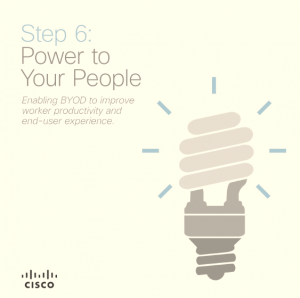































This is the sixth post in a blog series featuring Vine-format videos focusing on the"Six Essential Steps for Unleashing the Power of Enterprise Mobility".The first blog post discussing how to build a mobile structure can be foundhere. The second blog post highlighting the benefits going virtual can be foundhere. The third blog post focused on preparing enterprises for the division of devices can be foundhere. The fourth blog post focused on creating an app checkpoint can be found here. The fifth blog post focused on defending data can be foundhere.
 Watch video at http://youtu.be/3kD5EpXypFc
Watch video at http://youtu.be/3kD5EpXypFcOver the course of this series, we've discussed how enterprises can better enable people to work in their own way, regardless of where they are and what device they are using. We started by making smart plans at an architecture level and then implementing secure policies along the way. The final step enterprises need to take may be the hardest one of all but can yield the greatest results. To increase productivity, business agility, and customer satisfaction, enterprises must actively embrace mobility in the workplace. Here's a short checklist to help organizations with this last step:
1. Go Beyond Provisioning Mobility for Sales: Think "All-Company" Mobility.
The definition of mobility is expanding to include not just "road warriors" but also "corridor warriors," as well as guest and home workers.
Make sure your mobility architecture is designed to accommodate them all. Then create a phased implementation plan. Determine which users and business processes you want to prioritize first and move forward at a pace that makes sense for your enterprise.
An all-hands-on-deck approach will also help drive future implementation of mobile solutions.
 2. Redefine Workflows and Do More than Improve Business Processes.
2. Redefine Workflows and Do More than Improve Business Processes.
The true value of mobility is its ability to transform workflows. Look for ways to use mobility, not just for incremental process improvements, but also to change the way work is done in your organization. Below are a few examples of mobility in action:
For more information about creating an application strategy and additional steps to consider, check out Cisco's whitepaper, "Six Essential Steps for Unleashing the Power of Enterprise Mobility." Stay tuned for my next post that will summarize all the steps enterprises can take to unleash the power of mobility.
 Etiquetas calientes:
movilidad
Móvil móvil
Red red
Wi-Fi Wi-Fi Wi-Fi
BYOD
wireless
bring your own device
mobile device
enterprise mobility
Etiquetas calientes:
movilidad
Móvil móvil
Red red
Wi-Fi Wi-Fi Wi-Fi
BYOD
wireless
bring your own device
mobile device
enterprise mobility